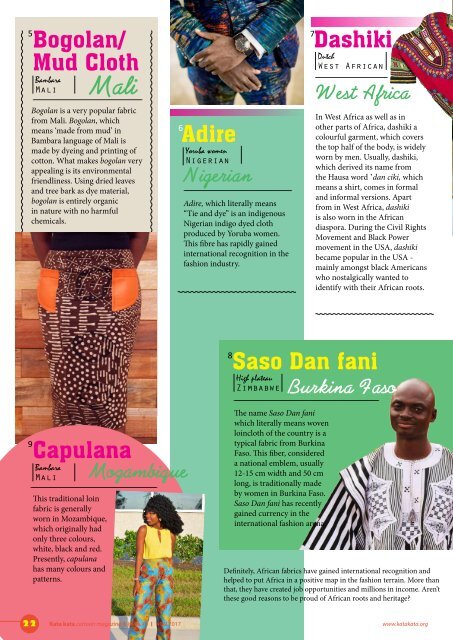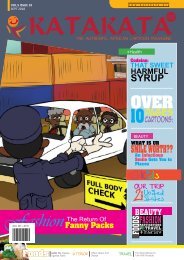You also want an ePaper? Increase the reach of your titles
YUMPU automatically turns print PDFs into web optimized ePapers that Google loves.
Bogolan/<br />
Mud Cloth<br />
Bambara<br />
Mali<br />
Mali<br />
Bogolan is a very popular fabric<br />
from Mali. Bogolan, which<br />
means ‘made from mud’ in<br />
Bambara language of Mali is<br />
made by dyeing and printing of<br />
cotton. What makes bogolan very<br />
appealing is its environmental<br />
friendliness. Using dried leaves<br />
and tree bark as dye material,<br />
bogolan is entirely organic<br />
in nature with no harmful<br />
chemicals.<br />
6<br />
Adire<br />
Yoruba women<br />
Nigerian<br />
Nigerian<br />
Adire, which literally means<br />
“Tie and dye” is an indigenous<br />
Nigerian indigo dyed cloth<br />
produced by Yoruba women.<br />
This fibre has rapidly gained<br />
international recognition in the<br />
fashion industry.<br />
7<br />
Dashiki<br />
Dutch<br />
West African<br />
West Africa<br />
In West Africa as well as in<br />
other parts of Africa, dashiki a<br />
colourful garment, which covers<br />
the top half of the body, is widely<br />
worn by men. Usually, dashiki,<br />
which derived its name from<br />
the Hausa word ʼdan ciki, which<br />
means a shirt, comes in formal<br />
and informal versions. Apart<br />
from in West Africa, dashiki<br />
is also worn in the African<br />
diaspora. During the Civil Rights<br />
Movement and Black Power<br />
movement in the USA, dashiki<br />
became popular in the USA -<br />
mainly amongst black Americans<br />
who nostalgically wanted to<br />
identify with their African roots.<br />
8<br />
Saso Dan fani<br />
High plateau<br />
Zimbabwe Burkina Faso<br />
9<br />
Capulana<br />
Mozambique<br />
Bambara<br />
Mali<br />
This traditional loin<br />
fabric is generally<br />
worn in Mozambique,<br />
which originally had<br />
only three colours,<br />
white, black and red.<br />
Presently, capulana<br />
has many colours and<br />
patterns.<br />
The name Saso Dan fani<br />
which literally means woven<br />
loincloth of the country is a<br />
typical fabric from Burkina<br />
Faso. This fiber, considered<br />
a national emblem, usually<br />
12-15 cm width and 50 cm<br />
long, is traditionally made<br />
by women in Burkina Faso.<br />
Saso Dan fani has recently<br />
gained currency in the<br />
international fashion arena.<br />
Definitely, African fabrics have gained international recognition and<br />
helped to put Africa in a positive map in the fashion terrain. More than<br />
that, they have created job opportunities and millions in income. Aren’t<br />
these good reasons to be proud of African roots and heritage?<br />
22 Kata kata cartoon magazine Issue <strong>16</strong> NOV 2017 www.katakata.org

















